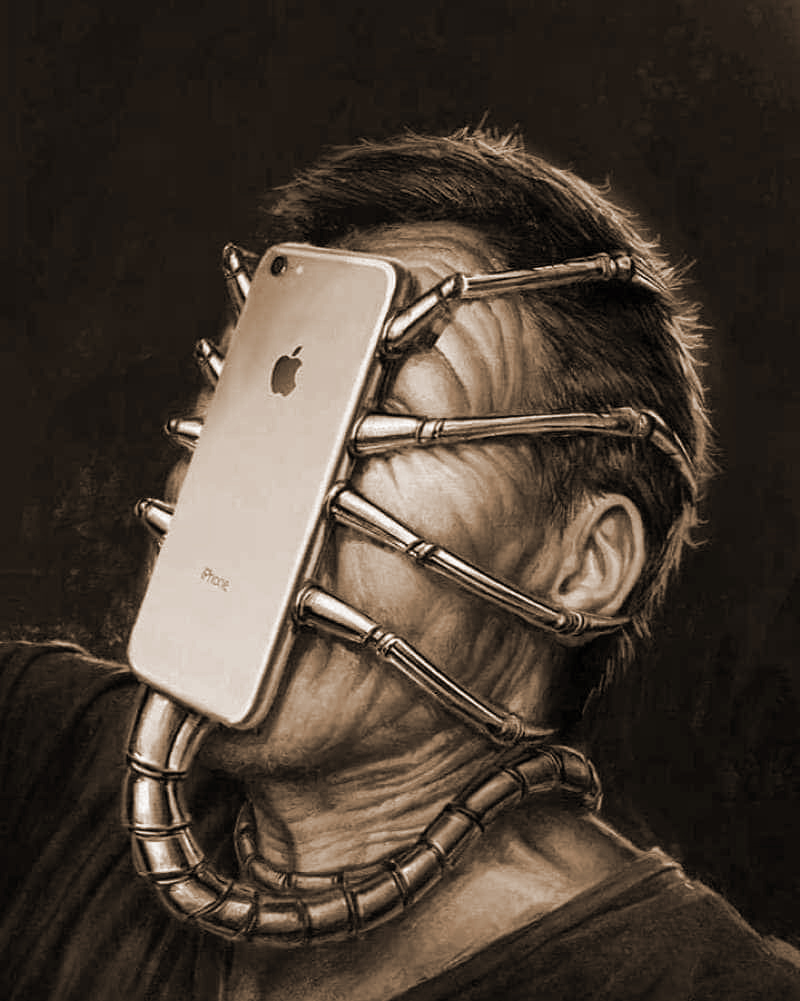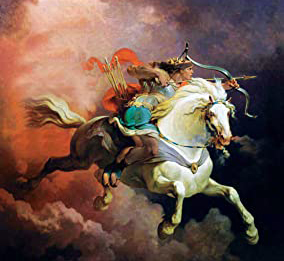Von Ferdinand Bardamu
(Aus dem Englischen ins Deutsche übertragen von Albus)
Die Krankheit des Christentums
Der Altphilologe Revilo P. Oliver bezeichnete das Christentum einmal als „geistige Syphilis“. Der Musiker Varg Vikernes sagte, das Christentum sei ein „Problem, das von der medizinischen Wissenschaft gelöst werden muss“. Er bezeichnete es als „HIV/AIDS des Geistes und der Seele“. Nur das Paradigma der sexuell übertragbaren Krankheit kann Licht auf die wahre Natur der christlichen Religion werfen.
Im Falle der Syphilis gibt es eine Latenzzeit. Dies ist vergleichbar mit dem Wachstum und der Verbreitung des Christentums im Römischen Reich bis zur Herrschaft Konstantins im frühen 4. Jahrhundert. Die Symptome einer syphilitischen Infektion nehmen an Schwere zu und führen zu einer Fülle von lebensbedrohlichen Folgen. Die durch die Syphilis verursachten neurologischen und kardiovaskulären Degenerationen schwächen den Körper des Wirtes. Hält die Infektion ohne ärztliches Eingreifen an, tritt der Tod ein. In ähnlicher Weise schwächt und zerstört das Christentum den Staat durch die Verbreitung seiner degeneriertesten und von ihm abgeleiteten Ideologien, wie Liberalismus, Sozialismus und Feminismus.
Das Christentum ist eine Perversion des Selbsterhaltungsstrebens. Das macht es zu einem Zerstörer ganzer Zivilisationen und Völker. Das Christentum anzunehmen ist nichts anderes, als sich eine Schlinge um den Hals zu legen und von einem hohen Gebäude zu springen. Es ist Selbstmord für alle, die sich dummerweise von seinen giftigen Lehren beeinflussen lassen. Die westliche Kultur wäre für immer verloren gewesen, wenn nicht die heidnische Wissenschaft und Philosophie in der Renaissance wiederentdeckt worden wäre. Zu unserem Leidwesen ist das Abendland erneut dieser geistigen Plage erlegen. Die himmlische Stadt Gottes sitzt nun über das Abendland zu Gericht. Der gekreuzigte Jude hat gesprochen: Der Okzident – gewogen und für zu leicht befunden!
Die Kirche hat die irdische Stadt Rom immer mit Verachtung betrachtet; die Wirtskultur, die die Religion so lange bebrütet hat, bedeutet dieser Hure Babylon, die sich vor allen Völkern der Welt prostituiert hat, nichts. Wenn die gesamte westliche Wissenschaft und Technologie über Nacht verschwinden würde, wäre die Kirche nicht im Geringsten davon betroffen; was zählt, ist, dass die Verkündigung des Evangeliums ohne Unterbrechung weitergeht, nichts anderes. Christentum und Orienierung an der Rasse sind im Grunde genommen unvereinbare Ideologien.
Der christlich Religiöse steht am Scheideweg; er muss sich entscheiden zwischen dem Evangelium oder dem Überleben der westlichen Zivilisation und der europäischen Rasse. Er kann nicht beides wählen. Ein echter christlicher Religiöser kann sich nur für das Überleben der christlichen Orthodoxie entscheiden, andernfalls wäre er ein Abtrünniger, dem das ewige Heil für immer verwehrt bliebe.
In einer Welt, in der das evolutionäre Überleben ein Nullsummenspiel ist, ist das Christentum der große Feind der europäischen Rasse und der westlichen Zivilisation.
Das Evangelium der semitischen Lügen?
Jesus Christus ist eine mythologische Figur. Die Erzählungen der Evangelien, seine persönlichen „Biografien“, beruhen nicht auf einer zugrunde liegenden historischen Realität. Was wir über Jesus wissen, stammt nicht von Augenzeugenberichten, sondern von weitgehend widersprüchlichem Hörensagen, verfasst etwa vierzig oder fünfzig Jahre nach seinem angeblichen Tod. Im Gegensatz zu dem mythischen Jesus, mit dem er oft verglichen wird, ist der Philosoph Sokrates in den historischen Aufzeichnungen wesentlich besser belegt. Zeitzeugen wie Platon und Xenophon schrieben detaillierte Berichte über das Leben und den Tod des Sokrates.
Die Entdeckung, dass es sich bei der ersten Christologie um eine „hohe“ Christologie handelte, ist ein weiterer Beweis für den mythologischen Ursprung Jesu. Dies steht im Gegensatz zu der von der älteren Bibelwissenschaft des 19. Jahrhunderts vertretenen Position, die vor allem von Wilhelm Boussets „religionsgeschichtlicher“ Schule vertreten wird. Dieser Ansatz wird am besten durch den heute vergessenen Kyrios Christos veranschaulicht. In diesem Werk vertrat Bousset die Ansicht, dass die kultische Verehrung Jesu erst dann Wirklichkeit wurde, als die ursprüngliche palästinensische Glaubensgemeinschaft hellenistischen und orientalischen Einflüssen ausgesetzt war.
Im Gegensatz zu Boussets „religionsgeschichtlichem“ Ansatz argumentieren moderne Bibelwissenschaftler, dass die ursprüngliche palästinensische Glaubensgemeinschaft mit einer „hohen“ Christologie begann. Maran atha war ein aramäisches Gebet, das den Titel Herr (YHWH) auf Jesus übertrug und ihn bat, sein Reich auf Erden zu errichten, um die eschatologischen Hoffnungen des Alten Testaments auf einen kommenden Messias zu erfüllen. Die „hohe“ Christologie, die die ersten palästinensischen Gläubigen vertraten, ebnete den Weg für die heidnischen Ansichten über Christus als Objekt religiöser Verehrung. Unter den frühesten heidnischen Gläubigen wurde Jesus verehrt, mit Gott selbst gleichgesetzt und als Kyrios bezeichnet, der griechischen Form des Tetragrammatons in der Septuaginta. Er war sogar das Ziel von Gebeten. Damit unterscheidet sich Jesus nicht von anderen mythologischen Figuren, die in der Antike verehrt wurden, wie Dionysos oder Herkules.
Die unausweichliche Schlussfolgerung ist, dass Jesus ein Hirngespinst ist, wie die Götter der alten Griechen. Denjenigen, die argumentieren, dass der jüdische Monotheismus ein Hindernis für die unmittelbare Vergöttlichung eines Sterblichen war, sei gesagt, dass die Logos-Theologie des hellenistischen Judentums das Wort Gottes erstmals in halb-anthropomorphen Begriffen darstellte und damit den Grundstein für den expliziten „binitarischen“ Charakter des Urchristentums legte.
Die Religion des Nahen Ostens schlechthin
Das Christentum ist in erster Linie eine Erfindung der meist ungebildeten palästinensischen Juden des 1. Jahrhunderts, von denen Saulus von Tarsus der einflussreichste war. Er änderte später seinen Namen in Paulus. Er war der Prototyp des „hässlichen mickrigen Juden“ der antiken Welt. Selbst Paulus musste zugeben, dass er von seinen Gegnern oft als „schwach“ oder „unscheinbar“ verunglimpft wurde. Eine außerkanonische Quelle aus dem 2. Jahrhundert verstärkt diesen Eindruck, indem sie den Apostel als klein, kahl, „breitbeinig“, mit langen Augenbrauen und Hakennase beschreibt. Er war die lebende Verkörperung des stereotypischen Juden. Wenn Paulus nur eine Karikatur gewesen wäre, hätte er sich bei den Juden in Streichers Der Stürmer gut aufgehoben gefühlt. Paulus war der erste, der das Christentum über das Mittelmeer verbreitete und der neuen Missionsreligion einen durch und durch expansionistischen Charakter verlieh. Er legte den Grundstein für die christliche Theologie und diente als ursprünglicher Katalysator für die „syphilitische“ Infektion, die nun Europa ruiniert hat.
Das Christentum ist die Religion des Nahen Ostens schlechthin. Nur weil die Sprache des Neuen Testaments Koine-Griechisch ist, ist diese Religion nicht weniger als eine semitische Erfindung. Das Gegenteil zu behaupten wäre so, als würde man die Analekten des Konfuzius ins Englische übersetzen und dann behaupten, der Konfuzianismus sei eine westliche Religion, weil das Medium, das für seine Übermittlung verwendet wird, die englische Sprache ist. Selbst die wenigen heidnischen Elemente in der Religion, wie die Verwendung des stoischen Logos im johanneischen Prolog, werden durch die Brille des alttestamentlichen Judentums gefiltert. Die Erzählungen der Evangelien sind jüdische Legenden, die auf jüdischen Vorstellungen von Messias, Auferstehung, Reich Gottes usw. beruhen. Das Christentum ist nicht nur durch und durch jüdischen Ursprungs, sondern auch die wichtigsten theologischen Lehren des Neuen Testaments sind aus dem Alten Testament und dem intertestamentarischen Judentum der griechischen und hasmonäischen Zeit abgeleitet. Die Verbreitung des Christentums über den Mittelmeerraum war das Werk unternehmungslustiger, umherziehender Juden.
Als das Christentum im Reich einen festen institutionellen Rahmen erhielt, begannen die Theologen, mit Juden und Heiden zu diskutieren, die der neuen Religion feindlich gegenüberstanden. Diese Diskussionen erforderten die Übernahme griechischer und lateinischer philosophischer Terminologie, um die orthodoxe Lehre präziser und klarer auszudrücken. Dies geschah nicht nur zu apologetischen Zwecken, sondern auch, um die kultivierten Heiden für sich zu gewinnen, indem man den semitischen Lehren des Urchristentums einen dünnen Anstrich intellektueller Seriosität verlieh. Trotz dieser kulturellen Anleihen bleibt das Christentum eine im Wesentlichen semitische Religion.
Eine Religion für einfältige Menschen
Gelehrte haben schon lange festgestellt, dass das Christentum schon immer eine große Anziehungskraft auf den untersten Abschaum der Menschheit ausgeübt hat. Nur wenige Intellektuelle wurden jemals von der Religion angezogen; diejenigen, die konvertierten, wurden zu anti-intellektuellen Extremisten, die der westlichen Kultur und Zivilisation den Rücken kehrten. Der lateinische Theologe Tertullian aus dem 2. Jahrhundert, einer der bigottesten christlichen Anti-Intellektuellen, der je gelebt hat, fragte berühmt: „Was hat Athen eigentlich mit Jerusalem zu tun? Welche Übereinstimmung gibt es zwischen der Akademie und der Kirche?… Wir wollen keine neugierige Disputation, nachdem wir nun Christus Jesus beitzen, keine weiteren Nachforschungen, nachdem wir des Evangeliums teilhaftig geworden! Mit unserem Glauben haben wir alles, wir wollen nichts anderes.“ Zeitgenössische heidnische Philosophen stellten häufig fest, dass die ersten Bekehrten aus den Reihen dummer, unwissender Menschen stammten. Celsus, ein früher heidnischer Kritiker der neuen Religion, schrieb, es sei christliche Politik, die Weisen und Gebildeten abzuweisen; nur Knaben, Narren und Sklaven kämen als potenzielle Konvertiten in Frage. „Ihre Lieblingsausdrücke“, schrieb Celsus, „sind: ‚Stell keine Fragen, glaube einfach!‘ und: ‚Dein Glaube wird dich retten!‘ ‚Die Weisheit dieser Welt‘, so sagen sie, ‚ist böse; einfältig zu sein, bedeutet gut zu sein‘.“
Das gebildete Heidentum verachtete den Volksglauben. Um des Glaubens würdig zu sein, mussten die Religionen logisch konsistent und empirisch fundiert sein. Sie mussten eine gewisse Grundlage in Wissenschaft und Philosophie haben. Alles andere war „Aberglaube“. „In der klassischen Antike wurde Aberglaube als Angst vor „Dämonen“ und als Glaube an die übernatürliche Verursachung natürlicher und physischer Phänomene, wie z. B. Krankheiten, definiert. Für die heidnischen Intellektuellen verkörperte das Christentum alles, was sie am Aberglauben verabscheuten. Was das Christentum besonders verwerflich machte, war, dass es die schlimmsten Eigenschaften des Judentums übernommen hatte, nämlich Intoleranz und Bigotterie. Außerdem verbreitete sich die Religion wie eine ansteckende Krankheit. So sah es der heidnische Intellektuelle: Das Christentum wurde von beschränkten Menschen für beschränkte Menschen erdacht und verbreitet, vor allem weil es dem Aberglauben der Massen sehr ähnlich war.
Der Siegeszug des Christentums führte in der Spätantike zu einer völligen Umkehrung der heidnischen Wertvorstellungen der Eliten. Der gebildete Mensch übernahm nun mit ganzem Herzen den Glauben der halbbarbarischen Menge. Der heilige Augustinus, der ursprünglich eine klassische Ausbildung genossen hatte und in Rhetorik geschult war, konnte mit Zuversicht behaupten, dass alle Krankheiten übernatürlichen Ursprungs seien, und setzte sich damit offen über die etablierte griechische medizinische Praxis hinweg. Während vor Konstantin eine beträchtliche Kluft zwischen dem Glauben der gebildeten Heiden und dem des einfachen Volkes bestand, gab es nach Konstantin keine solche Kluft mehr. Zum ersten Mal in der klassischen Antike waren die Elite und die Massen in Bezug auf den Glauben nicht mehr zu unterscheiden, und alle hingen naiv der Verehrung von Heiligen, ihren Reliquien und Wundern an.
Der Triumph des Christentums im Westen war der Triumph einer tiefgreifenden Beschränktheit, die Jahrhunderte andauerte.
Das Christentum: Zerstörer von Imperien
Das Christentum war ein Schlüsselfaktor für den Niedergang Roms. Als die Kirche zur dominierenden Institution der Spätantike wurde, belastete sie die wirtschaftlichen Ressourcen des Reiches erheblich. Dabei handelte es sich nicht um einen einfachen Vermögenstransfer; die Gelder für heidnische Tempel und Heiligtümer wurden nicht einfach aus den weltlichen Kassen abgezweigt, um das kirchliche Wachstum zu finanzieren. Anders als die heidnischen Kulte wurde die nizäische Staatsreligion von einer riesigen zentralisierten Bürokratie verwaltet, deren Reichweite das ganze Reich umfasste und deren Beamte zahlreicher und besser bezahlt waren als die des Staates. Einnahmen, die für die Verbesserung der Infrastruktur wie den Bau von Straßen, Brücken, Aquädukten und Theatern hätten verwendet werden können, flossen in den Bau nutzloser Gebäude wie Kirchen und Klöster und in die Ernährung von „Müßiggängern“: Mönchen, Priestern und Bischöfen, die nichts von materiellem oder wirtschaftlichem Wert für den Staat beitrugen. Diese enorme Verschwendung von Ressourcen wird noch erstaunlicher, wenn man den relativ niedrigen Stand der technischen und wissenschaftlichen Entwicklung im Reich bedenkt. Wirklich arbeitssparende Geräte waren selten, so dass produktive Arbeit von Hand oder mit Hilfe von Ochsen verrichtet wurde. Die Menge an Arbeitskräften, die benötigt wurde, um die „nutzlosen Mäuler“ der christlichen Kirche zu ernähren, zu kleiden und unterzubringen, war erheblich größer als die eines typischen Beamten im römischen Staatsdienst.
Die enormen Talente von Männern wie Athanasius und Johannes Chrysostomus, die als fähige Generäle und Herrscher besser für die Verteidigung des Reiches geeignet gewesen wären, wurden stattdessen für die Ausweitung der Macht und des Einflusses der Kirche im täglichen Leben verschwendet. In der Tat ist die Verschwendung wertvoller Arbeitskraft und materieller Ressourcen im Dienste „nutzloser Mäuler“ ein wiederkehrendes Thema in der Geschichte des Christentums. Die christliche Sorge um „nutzlose Mäuler“ hatte eine zutiefst dysgenische Wirkung auf den europäischen Genpool. Die geistige Elite Europas wurde ermutigt, sich aus der Gesellschaft zurückzuziehen und sich der spirituellen Disziplin der ewigen Keuschheit oder Jungfräulichkeit zu verschreiben, anstatt ihre Gene weiterzugeben. Dies wirkte sich negativ auf den durchschnittlichen IQ der Bevölkerung aus und hinterließ der Kirche eine Fülle leicht zu kontrollierender und gefügiger Leibeigener, die mit jeder Generation weniger in der Lage waren, die Zivilisation um sie herum zu erhalten. Thomas von Aquin ist das Hauptopfer dieser zerstörerischen Verschwendung menschlicher Talente. Sein Genie wäre in der Medizin oder der Experimentalphysik besser aufgehoben gewesen; stattdessen wurde es törichterweise für die Engelslehre und anderen mittelalterlichen Aberglauben vergeudet.
Die schlimmsten Zerstörungen, die dem westlichen Reich zugefügt wurden, wurden natürlich von Christen verübt. Die große Plünderung Roms im Jahr 411 – die als entscheidender Moment für den Niedergang des Abendlandes gilt – wurde von einem arianischen Christen verübt. Die Plünderung Roms im Jahr 455, die noch verheerender war als der erste Barbareneinfall in die ewige Stadt, wurde von einem anderen Christen verübt, der zuvor das Reich geschwächt hatte, indem er die Provinz Afrika als sein persönliches Lehen an sich riss. Und natürlich war auch derjenige, der den endgültigen Gnadenstoß versetzte, der die römische Kaiserherrschaft im Westen beendete und das dunkle Mittelalter in Westeuropa einleitete, ein Christ.
Apologeten leugnen in der Regel die Rolle des Christentums beim Niedergang des Reiches und erwidern, dass Byzanz den Untergang des lateinischen Westens überlebt hat. Unsere christlichen Rechtfertiger übersehen dabei, dass der Osten reicher und bevölkerungsreicher war. Dadurch konnte der byzantinische Staat den enormen internen Schaden, der durch die Plünderungen des parasitären nizäischen Staatskultes verursacht wurde, besser auffangen. Es gibt auch geografische Gründe für das Überleben von Byzanz. Der östliche Kaiser hatte eine viel kürzere Grenze zu verteidigen. Konstantinopel, die kaiserliche Hauptstadt, war von einer Reihe massiver Befestigungsanlagen umgeben, die von Konstantin begonnen worden waren und im frühen 5. Jahrhundert vollendet wurden. Diese waren für barbarische Angreifer praktisch uneinnehmbar. Anders als der Osten hatte der Westen keine zweite Verteidigungslinie.
Der nizäische Staatskult zwang Rom in die Knie und zog den Vorhang über dem klassischen Altertum zu. Der zivilisatorische Zusammenbruch, der darauf folgte, ist als das dunkle Zeitalter bekannt, in dem das nachrömische Europa einen erheblichen Rückgang des Lebensstandards erlebte. In der Zeit, in der die Christen am mächtigsten waren, verfielen die Straßen und Überlandwege, die das Reich durchzogen; Brücken und Aquädukte wurden praktisch nicht mehr benutzt; das Wissen um das Bauen mit Stein und Mörtel verschwand fast völlig; die Alphabetisierung, soweit sie überhaupt vorhanden war, verschwand mit Ausnahme des Klerus; die persönlichen Hygienestandards verschwanden; es gab keine Sanitäranlagen mehr in den Häusern; große Teile des ehemaligen Reiches wurden entvölkert, und schließlich wurde auch die Verwendung von Münzen fast völlig eingestellt, was das Ende der komplexen Geldwirtschaft der römischen Zeit bedeutete. Die christliche Hegemonie in Byzanz führte zu einer jahrhundertelangen wissenschaftlichen und technologischen Stagnation. Es gab sogar ein Byzantinisches Dunkles Zeitalter, das Hunderte von Jahren andauerte. In dieser Zeit schrumpften die Grenzen, die Städte wurden auf befestigte Enklaven reduziert, das Geld wich dem Tauschhandel, und die byzantinische Literatur bestand aus einer Fülle fader Hagiographie.
Dies war die Welt des Christentums: eine Welt tiefster Unwissenheit und Dummheit, in der brutale Männer unter dem Deckmantel der Religion eine schwache und hilflose Bevölkerung tyrannisierten. Das dunkle Zeitalter war das Geschenk des Christentums an Europa. Es wurde von Christen eingeführt, von Christen geleitet und von Christen jahrhundertelang aufrechterhalten. Europa erlebte eine seiner dunkelsten Stunden, als die Christen auf dem Höhepunkt ihrer Macht und ihres Einflusses waren.
Das Christentum: Bringer der Unwissenheit
Das Christentum ist gefährlich, weil es Ignoranz und Dummheit über die Vernunft stellt. Im Evangelium ermutigt Jesus seine Jünger, wie „Schafe“ zu sein, die dümmsten und fügsamsten aller Tiere. Hier ist der ideale Christ eine Person mit geringer Intelligenz und wenig Bildung. Jesus sagt, dass man nicht in das Himmelreich kommen kann, wenn man nicht wieder ein Kind wird. Als Antwort auf den zweifelnden Thomas sagte Jesus: „Selig sind, die nicht sehen und doch glauben.“ Der Apostel Paulus griff diesen Standpunkt auf, als er schrieb: „Die Weisheit dieser Welt ist eine Torheit in den Augen Gottes.“ Durch ein Programm religiöser Indoktrination von der Wiege bis zur Bahre zwang die Kirche die Europäer, diese Überzeugungen als göttlich geoffenbarte Wahrheiten des Himmels zu akzeptieren. Die weit verbreitete Akzeptanz dieser Überzeugungen trug dazu bei, den wissenschaftlichen und technischen Fortschritt in Europa über tausend Jahre lang zu bremsen.
Die Kirchenväter propagierten die „heilige Unwissenheit“ als ein Ideal, dem man nacheifern sollte. Tertullian ist unter den patristischen Schriftstellern für seinen militanten Anti-Intellektualismus bekannt. Obwohl er zu den prominentesten Verächtern der klassischen Philosophie und Wissenschaft gehörte, war er keineswegs in der Minderheit. Seine Haltung ist typisch für kirchliche Amtsträger in der patristischen und mittelalterlichen Zeit. Zu dieser langen Liste christlicher Fanatiker gehört auch Tatian, ein bekannter Apologet, der alle heidnischen wissenschaftlichen und philosophischen Errungenschaften als wertlos, ja sogar als schädlich für die christlichen Gläubigen ansah. Clemens von Alexandrien, ein weiterer prominenter vornizäischer Schriftsteller, vertrat die Ansicht, dass Bildung für das Heil nicht notwendig sei. Origenes gab seine umfangreiche Sammlung heidnischer Literatur wegen der grundsätzlichen Unvereinbarkeit von weltlicher Bildung und Bibelstudium weg. Die Apostolischen Konstitutionen aus dem 4. Jahrhundert, ein frühes Werk des kanonischen Rechts, das im Osten als maßgebend galt, befiehlt dem gläubigen Christen, alles heidnische Lernen als „fremdartig“ und „teuflisch“ zu meiden.
Basilius von Caesarea riet den Gläubigen: „Lasst uns Christen die Einfachheit unseres Glaubens den Demonstrationen der menschlichen Vernunft vorziehen … Denn viel Zeit mit der Erforschung des Wesens der Dinge zu verbringen, würde der Aufrichtung der Kirche nicht dienen.“ Ironischerweise wird Basilius von den Apologeten des Christentums als ein Beispiel für Mäßigung angesehen. Er war der Ansicht, dass der Nutzen heidnischer Literatur vom Grad der Übereinstimmung mit der Heiligen Schrift abhängen sollte, was Philosophie und Wissenschaft zu einer Art zweit- oder drittklassiger Magd der Theologie machte. Die Schriften, die am wenigsten mit der Bibel übereinstimmten, also fast alle weltliche Philosophie und Wissenschaft, sollten in den Mülleimer geworfen werden.
Athanasius von Alexandria verachtete alle weltliche Weisheit als Blasphemie gegen den gekreuzigten Gott. In seiner berühmten Hagiographie des heiligen Antonius wird der ungebildete Mönch als weiser Mann dargestellt. Trotz seines Analphabetentums gilt Antonius’ Einsiedlerdasein als „vollendetes Vorbild für ein anachoretisches Leben“. Antonius bittet sogar heidnische Philosophen, die ihn besuchen, in seiner „Weisheit“ ihm gleich zu werden, obwohl er keine Ahnung von weltlicher Bildung hat.
Die Predigten von Johannes Chrysostomus, einem bekannten Anti-Intellektuellen des 4. Jahrhunderts, sind voll von abscheulichen Verurteilungen von Philosophie und Wissenschaft. Er forderte die Gläubigen sogar regelmäßig auf, ihren Geist von aller weltlichen Weisheit zu befreien. Johannes wetterte routinemäßig gegen das klassische Erbe und befürwortete dessen systematische Ausrottung, aber nur, um die Macht und den Einfluss des Evangeliums im täglichen Leben zu verstärken. Johannes predigte vor einem elitären Publikum in Konstantinopel und vertrat die Vision eines radikal reinen und asketischen Christentums, das von allen heidnischen Einflüssen befreit war. In Anbetracht seiner rednerischen Fähigkeiten und seiner beträchtlichen Invektiven sowie seines hohen Ranges im patristischen Kanon kann kein Zweifel daran bestehen, dass Johannes’ großer Hass auf das weltliche Wissen bei der Entscheidung der Kirche, die Schriften der klassischen Antike zu zensieren und zu unterdrücken, eine einflussreiche Rolle spielte.
Johannes Cassian, der große geistliche Führer der lateinischen Christenheit, riet dem Mönch, zu seiner persönlichen Erbauung die Gesellschaft ungebildeter Bauern aufzusuchen. Der Abt Arsenius, ein ehemaliger kaiserlicher Hauslehrer, betrachtete seine Bildung in klassischem Griechisch und Latein als minderwertig gegenüber der „Weisheit“ der ungebildeten ägyptischen Mönche. Der christliche Asket und Theologe Evagrius Ponticus (4. Jahrhundert) erklärte: „Selig ist der Mensch, der unendliche Unwissenheit erlangt hat.“ Die Statuta Ecclesia Antiqua aus dem 5. Jahrhundert verbot dem Klerus die Lektüre heidnischer Bücher, es sei denn, deren antichristliche und ketzerische Ansichten mussten widerlegt werden. Dies wurde in das Decretum Gratiani aus dem 12. Jahrhundert aufgenommen, das bis 1918 eine Quelle des Kirchenrechts der römischen Kirche war.
Obwohl das Christentum als eine Schriftreligion gilt, wurden die christlichen Lehren bis zur Erfindung des Buchdrucks durch Gutenberg im Jahr 1440 mündlich weitergegeben. Das patristische und mittelalterliche Christentum sah die Alphabetisierung in einem negativen Licht. Die kirchliche Tradition hatte immer behauptet, dass die ersten Apostel in einem Zustand „gesegneter Unwissenheit“ lebten. In Nachahmung dieser Männer weigerten sich die Christen, ihren Gemeinden das Lesen und Schreiben beizubringen, insbesondere in den ersten drei Jahrhunderten des Bestehens der Kirche. Die vornizäische Kirche erstellte keine Bibelübersetzungen für die einheimische Bevölkerung in den Provinzen und an den Grenzen, obwohl diese seit den ersten Tagen des Urchristentums in regelmäßigem Kontakt mit reisenden Missionaren stand. Die wenigen patristischen Ermahnungen zum Bibellesen richteten sich an eine kleine Minderheit von gebildeten Christen. Jahrhunderte theologischer Kontroversen trugen dazu bei, dass das Bibellesen als subversives Unterfangen angesehen wurde. Der Klerus riet aktiv davon ab und sorgte dafür, dass das einfache Volk unter seiner Obhut über Generationen hinweg Analphabeten bleiben würde. Im Mittelalter wurden Kirchenkonzilien einberufen, um den Laien den Besitz der Bibel in lateinischer oder einer der romanischen Sprachen zu verbieten. Wer dabei ertappt wurde, dass er die Bibel in die Volkssprache übersetzte, auf den wartete der Scheiterhaufen.
Die Paideia [Erziehung, Bildung] litt unter der neuen kirchlichen und christlich-kaiserlichen Bürokratie. Die Beamten von Kirche und Staat hatten Wichtigeres zu tun, als kleinen Kindern die Grundzüge der lateinischen Grammatik und des Rechnens beizubringen. Der Analphabetismus nahm zu und verbreitete sich unter christlichem Einfluss weiter. Die bildungsfeindlichen Prioritäten der Kirche, die im Laufe der Zeit immer stärker wurden, hielten immer mehr Menschen davon ab, Bildung zu erlangen.
Dies setzte sich fort, bis die Alphabetisierung aus ganzen Regionen des nachrömischen Europas verschwand. Die tief sitzende Feindseligkeit der christlichen Kirche gegenüber Lernen und Gelehrsamkeit sowie ihre positive Einschätzung von Unwissenheit und Analphabetismus hielten das westliche Europa über Jahrhunderte auf einem prähistorischen Entwicklungsstand.
Das 4. Jahrhundert, in dem das Christentum seinen Siegeszug antrat, war eine Zeit des bedeutenden geistigen Niedergangs. Es gab keine großen Persönlichkeiten in Wissenschaft, Architektur oder Medizin. Im 4. Jahrhundert gab es keine Philosophen vom Kaliber eines Plotin; es gab keine großen Schriftsteller oder Dramatiker. Die Schulen wurden geschlossen, die höheren Studien wurden aufgegeben, und die heidnischen Bibliotheken wurden verschlossen. Die intellektuellen und künstlerischen Erzeugnisse der Zeit waren von geringer Tiefe und Substanz. Die allgegenwärtige christliche Feindseligkeit gegenüber dem Leben des Geistes führte zu diesem Zeitalter der Sterilität.
Die christliche Zerstörung des künstlerischen Erbes Europas
Theodosius war der erste christliche Kaiser, der dem Heidentum systematisch den Garaus machte. Er begann mit einer Reihe von drakonischen Maßnahmen, kurz nachdem er 380 n. Chr. das nizäische Christentum zur offiziellen Staatsreligion erklärt hatte. Gegen Ende seiner Regierungszeit wurden die Gesetze zum Verbot der hellenistischen Religion – die so genannten Theodosianischen Dekrete – immer härter. Dieses kaiserliche Programm des kulturellen Völkermords mündete in den letzten Jahrzehnten des 4. Jahrhunderts in eine Orgie der Gewalt und Zerstörung.
Der kommende Sturm wurde von dem christlichen Fanatiker Maternus Cynegius vorausgesagt, der 384 von Theodosius zum Prätorianerpräfekten ernannt wurde. Unter dem kaiserlichen Befehl, heidnische Opfer und Weissagung zu unterdrücken, startete er seinen ganz persönlichen Kreuzzug gegen die hellenistische Religion. Mit Hilfe von Bischöfen, Priestern und einem Heer randalierender Mönche zerstörte Cynegius einige der heiligsten Stätten im griechischen Osten. Viele dieser Gebäude beherbergten die größten Kunstschätze des Altertums.
Archäologische Funde aus dem östlichen Mittelmeerraum belegen eine erhebliche Zerstörung und Schändung von Tempeln. Dies kann auf die Zeit von Cynegius’ Tätigkeit im Osten datiert werden. Zeitgenössische hagiografische Quellen wie die Vita Porphyrii bezeugen die spektakuläre religiöse Gewalt gegen die heidnischen Heiligtümer und Tempel in der Levante. Im Jahr 386 flehte der heidnische Redner Libanius, ein scharfer Kritiker des christlichen Bildersturms, Theodosius an, die Tempel und Heiligtümer des Reiches zu erhalten. Er sprach von Heerscharen „schwarzgekleideter Mönche“, Vielfraße und Trunkenbolde, die „mit Stöcken, Steinen und Eisenstangen und in manchen Fällen, wenn sie diese verschmähen, mit Händen und Füßen auf die Tempel losgehen. Dann folgt die völlige Verwüstung, das Abreißen der Dächer, der Abriss der Mauern, das Niederreißen der Statuen und das Umstürzen der Altäre, und die Priester müssen entweder stillhalten oder sterben. Nachdem sie einen Altar abgerissen haben, eilen sie zu einem anderen und zu einem dritten, und Trophäen stapeln sich auf Trophäen, entgegen dem Gesetz. Solche Schandtaten kommen sogar in den Städten vor, aber am häufigsten sind sie auf dem Lande. Der Feinde sind viele, die die einzelnen Angriffe verüben, aber nach ihren zahllosen Verbrechen versammelt sich dieses versprengte Gesindel, und sie sind in Ungnade gefallen, es sei denn, sie haben die übelste Schandtat begangen…“
Die Christen verwüsteten nicht nur Tempel, sie verstümmelten auch heidnische Statuen und verunstalteten Inschriften. Die gewaltsame Zerstörung heidnischer religiöser Artefakte ist archäologisch gut belegt in der Levante und in Afrika, wo die christlichen Bilderstürmer am aktivsten waren. Dieses Zerstörungsmuster erstreckte sich über das gesamte Reich und lässt sich auch an so weit entfernten Orten wie Nordwestgallien und Britannien nachweisen. Weitaus zerstörerischer als die Zerstörung der Tempel durch christliche Eiferer war die kaiserliche Anti-Heiden-Gesetzgebung, die alle Subventionen für die einst blühenden polytheistischen Kulte des Reiches beendete. Ohne Zuschüsse aus der kaiserlichen Staatskasse konnten die Heiden ihre religiösen Monumente nicht mehr instand halten und reparieren. Verstärkt wurde dies durch zusätzliche Gesetze, die die Schließung aller Heiligtümer und Tempel anordneten und Heiden mit dem Tod bedrohten, wenn sie weiterhin Haruspizien und Tieropfer praktizierten. Dies führte dazu, dass die wichtigsten Bauwerke und Kunstdenkmäler des Reiches dauerhaft dem Verfall preisgegeben waren und schließlich zu Grunde gingen.
Der weit verbreitete christliche Vandalismus der Spätantike war die größte Kampagne der Weltgeschichte zur Zerstörung des künstlerischen und architektonischen Erbes einer ganzen Zivilisation. Diese Kampagne zur Auslöschung der großen Monumente der Antike aus dem Gedächtnis war wesentlich zerstörerischer als die barbarischen Invasionen des 5. Jahrhunderts. Die Christen des späten Kaiserreichs waren die ISIS oder die Taliban ihrer Zeit, auch wenn dies eine Untertreibung sein mag, da die Christen um ein Vielfaches zerstörerischer waren. Ohne diese zusätzliche Zutat der ritualisierten Gewalt wäre das Christentum nie die dominierende Religion der antiken Welt geworden.




